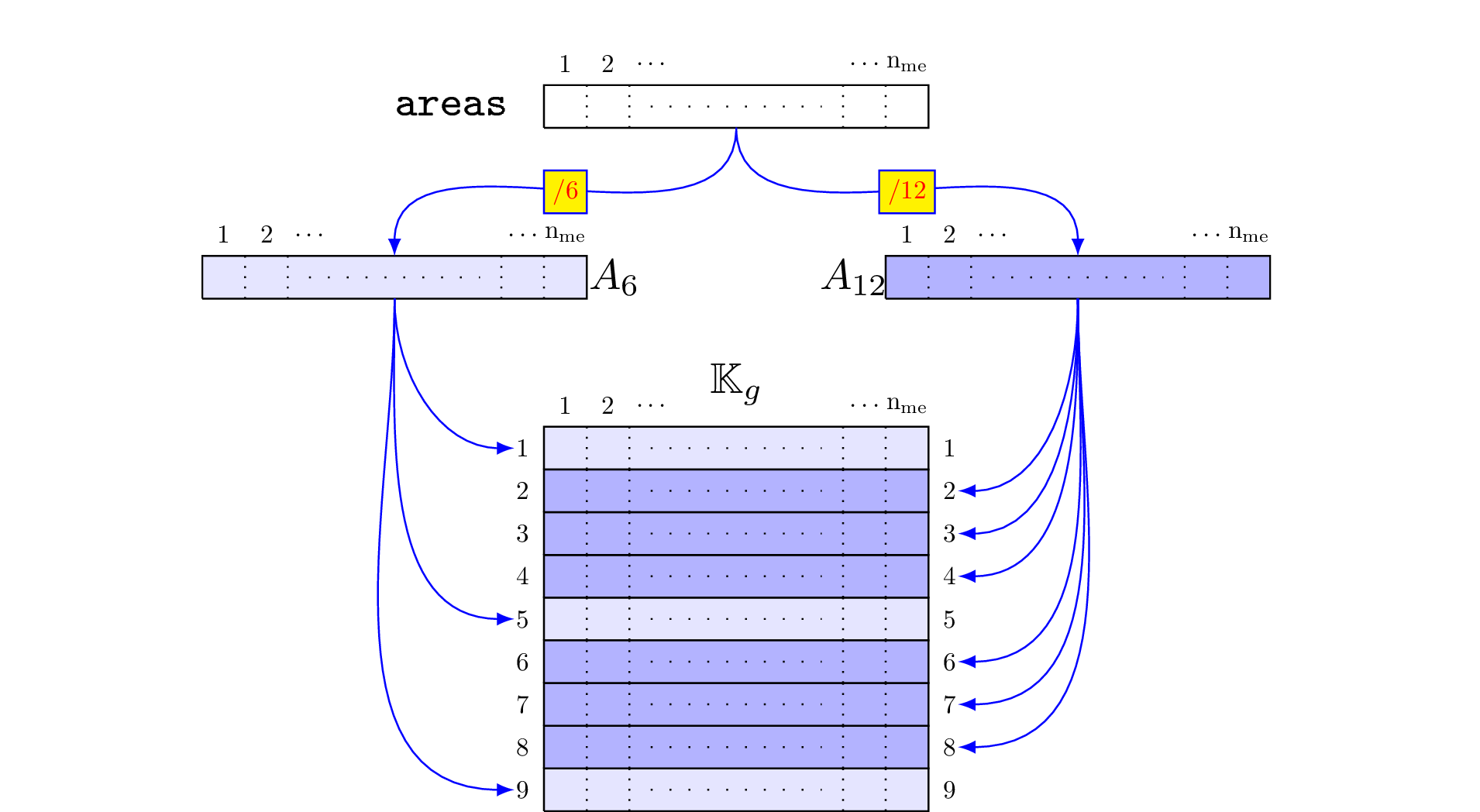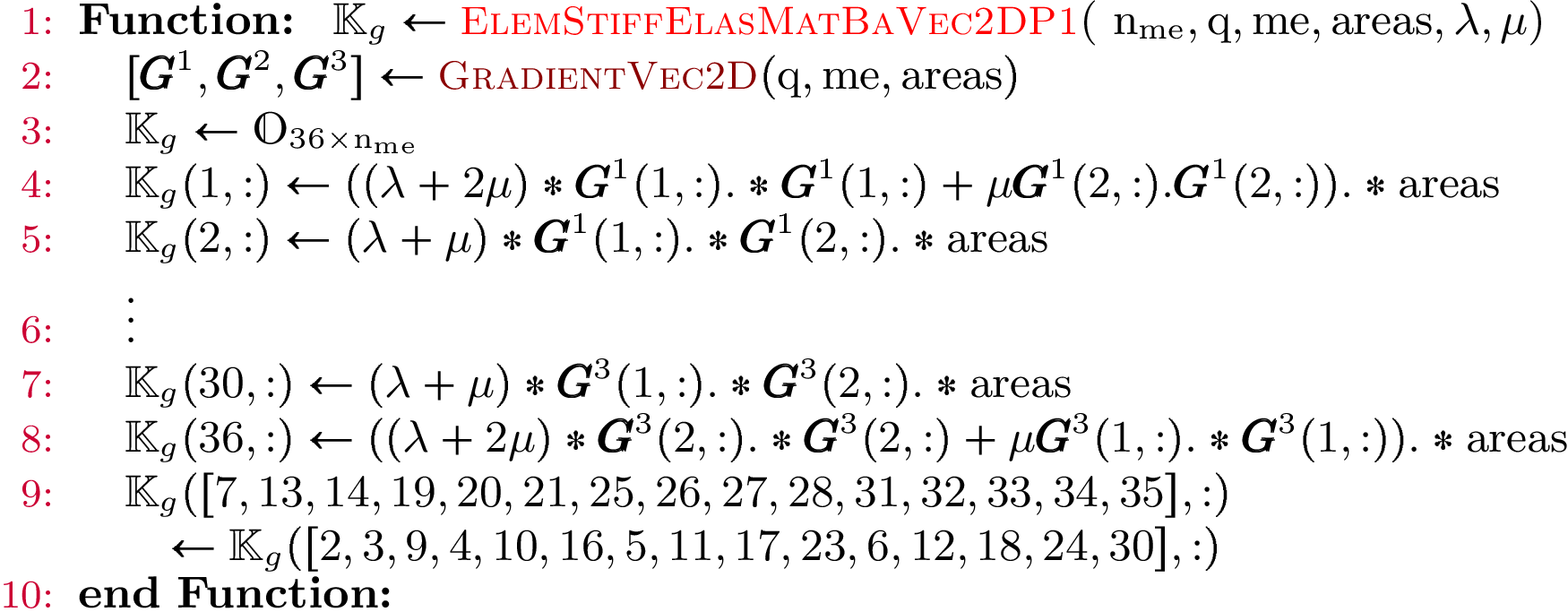Element Mass Matrix¶
We have

Then with  definition (see Section New Optimized assembly algorithm (OptV2 version)) , we obtain
definition (see Section New Optimized assembly algorithm (OptV2 version)) , we obtain

We represent in figure 13 the corresponding row-wise operations.
So the vectorized algorithm for  computation is simple and given in Algorithm 14.
computation is simple and given in Algorithm 14.
Algorithm 14
Note
- pyOptFEM.FEM2D.elemMatrixVec.ElemMassMat2DP1Vec(areas)[source]
Computes all the element Mass matrices
 for
for 
Parameters: areas (  numpy array of floats) – areas of all the mesh elements.
numpy array of floats) – areas of all the mesh elements.Returns: a one dimensional numpy array of size 
Element Stiffness Matrix¶
We have 

Using vectorized algorithm function  given in Algorithm 12, we obtain
the vectorized algorithm 15 for
given in Algorithm 12, we obtain
the vectorized algorithm 15 for  computation for the Stiffness matrix in 2d.
computation for the Stiffness matrix in 2d.
Algorithm 15
Note
- pyOptFEM.FEM2D.elemMatrixVec.ElemStiffMat2DP1Vec(nme, q, me, areas)[source]
Computes all the element stiffness matrices
 for
for 
Parameters: - nme (int) – number of mesh elements,
- q (
 numpy array of floats) – mesh vertices,
numpy array of floats) – mesh vertices, - me (
 numpy array of integers) – mesh connectivity,
numpy array of integers) – mesh connectivity, - areas (
 numpy array of floats) – areas of all the mesh elements.
numpy array of floats) – areas of all the mesh elements.
Returns: a one dimensional numpy array of size

Element Elastic Stiffness Matrix¶
We define on
 the local alternate basis
the local alternate basis  by
by
where
 With notations of Presentation, we have
With notations of Presentation, we have


with,


(1)

For example, we can explicitly compute the first two terms in the first column of
 which are given by
which are given by
and

Using vectorized algorithm function
 given in Algorithm 12, we obtain
the vectorized algorithm 15 for
given in Algorithm 12, we obtain
the vectorized algorithm 15 for  computation for the Elastic Stiffness matrix in 2d.
computation for the Elastic Stiffness matrix in 2d.Algorithm 16
Note
- pyOptFEM.FEM2D.elemMatrixVec.ElemStiffElasMatBaVec2DP1(nme, q, me, areas, L, M, **kwargs)[source]
Computes all the element elastic stiffness matrices
 for
for  in local alternate basis.
in local alternate basis.Parameters: Returns: a (36*nme,) numpy array of floats.
We define on
 the local block basis
the local block basis  by
by
where

For example, using formula (1), we can explicitly compute the first two terms in the first column of
 which are given by
which are given by
and

Using vectorized algorithm function
 given in Algorithm 12, we obtain
the vectorized algorithm 17 for
given in Algorithm 12, we obtain
the vectorized algorithm 17 for  computation for the Elastic Stiffness matrix in 2d.
computation for the Elastic Stiffness matrix in 2d.Algorithm 17
Note
- pyOptFEM.FEM2D.elemMatrixVec.ElemStiffElasMatBbVec2DP1(nme, q, me, areas, L, M, **kwargs)[source]
Computes all the element elastic stiffness matrices
 for
for  in local block basis.
in local block basis.Parameters: Returns: a (36*nme,) numpy array of floats.




 Lame parameter,
Lame parameter, Lame parameter.
Lame parameter.
